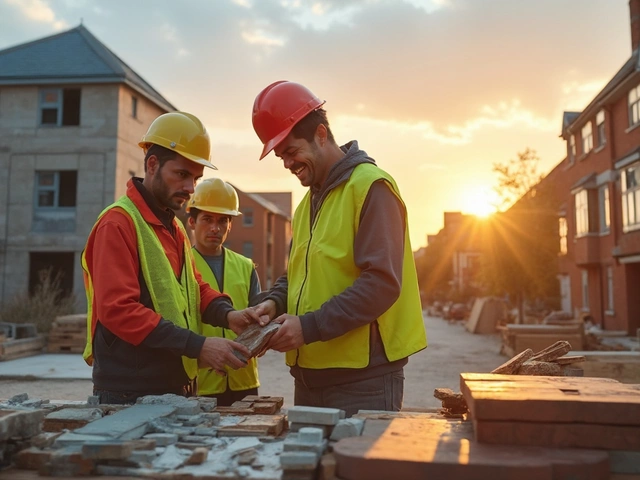
Ever caught yourself squinting at regulations, trying to decode what 'commercial' means in federal law? You're not alone. In the world of construction, understanding these terms is your secret weapon. The term ‘commercial’ at the federal level doesn't just describe a business; it's about how a property functions, from office buildings to multi-use spaces.
Why should you care? Well, the label 'commercial' influences everything from the permits you need to the taxes you pay. It affects how you navigate the thicket of zoning laws and construction codes. Getting a handle on these definitions helps avoid headaches down the road.
Think of it this way: if you're putting your hard-earned cash into a construction project, knowing the federal ins-and-outs can save you time and money. It’s about building smarter, not just bigger. Stick around as we unpack the federal implications and give you some handy tips for staying on the right side of the law.
- The Federal Take on 'Commercial'
- Impact on Construction Projects
- Navigating Zoning and Regulations
- Practical Tips for Compliance
The Federal Take on 'Commercial'
When it comes to commercial construction, the federal definition of 'commercial' is like the secret sauce. It’s essential for developers and builders to understand this definition, as it's packed with guidelines that dictate how projects should be executed. At the most basic level, a commercial property refers to real estate intended for business activities. This can range from office buildings to giant shopping malls, covering a wide range of uses.
The National Association of Realtors highlights that distinguishing a building's use impacts not just construction codes, but also the safety regulations that need to be followed. As quoted from their 2023 report,
“Understanding the federal distinction helps streamline compliance and minimizes project delays due to incorrect categorization.”In other words, having this knowledge up front saves both time and money.
Why it Matters for Builders
For those knee-deep in blueprints, it's the federal definition that guides everything from zoning regulations to the nitty-gritty of permits. Ignorance in this area can lead to costly mistakes. So how does this affect your project's budget? Let’s break it down: zoning violations can result in significant fines, and non-compliance with building codes might mean tearing down and starting over.
- Zoning Laws: Ensure that your project is in the right area; a commercial label might mean no residential homes nearby.
- Permits and Codes: Different permits are required based on a project's commercial status, impacting project timelines.
- Safety Regulations: All commercial properties must adhere to federally mandated safety requirements, which can differ significantly from residential standards.
The Impact of Regulations
Federal regulations work like a rubric for your project. Recently, a study from the American Planning Association found that 75% of commercial projects face delays due to misunderstandings of federal definitions and regulations. These regulations are there to ensure that commercial properties serve their intended purpose effectively and safely, but understanding them from the get-go is crucial.
For anyone planning to dive into the commercial construction scene, investing time into learning these rules is as critical as hiring a qualified architect. Trust me, knowing the playing field levels up your game.
Impact on Construction Projects
Diving into the world of commercial construction means keeping an eye on how federal regulations play a role. They're more than just words on a page; these rules really shape how projects unfold.
So, what’s the deal? The federal definition has big implications for the design, planning, and execution stages of construction. For design, it often means incorporating features that cater to business operations, like having enough parking or specific amenities.
Permits and Approvals
Getting started isn't simple. You'll need to grab the right permits. For anything labeled commercial, this often includes additional steps compared to residential projects. It's smart to partner closely with local officials who are well-versed in federal standards. They’ll help navigate the permit maze more efficiently.Safety codes and environmental regulations are also a big deal. Structures need to align with safety standards, which might mean tougher materials or tech upgrades. For those dealing with renovations, retrofitting older buildings to meet new standards can be quite a task!
On the financial side, commercial projects often require a deeper pocket. Construction costs might go up due to special structural requirements or technology needed to comply with various federal codes.
Zoning Challenges
There's more at play with zoning. Commercial zoning guidelines dictate everything from building height to the types of businesses allowed in a location. You'll want to make sure your project aligns perfectly to avoid costly pauses or legal hiccups.Statistics Snapshot
Still curious about numbers? Check out this simple table summarizing how different types of commercial construction projects vary in terms of regulation:
| Type of Project | Typical Regulation Requirements |
|---|---|
| Office Buildings | High on safety codes, accessibility features |
| Retail Spaces | Focus on customer flow, signage rules |
| Mixed-Use Developments | Complex zoning, multi-faceted permit needs |
In short, understanding how federal definitions and related laws impact commercial construction is key to a smooth project. This includes getting the right permits, meeting safety standards, and navigating zoning laws effectively. With the right approach and some local guidance, you’re set to build with confidence.

Navigating Zoning and Regulations
So you're gearing up for a commercial construction project, but the labyrinth of zoning and regulations is making your head spin. Let's break it down. Zoning laws are like the rulebook that says what you can and can't do with your property. They're designed to ensure that a factory doesn't open shop next to a peaceful residential neighborhood.
First off, check out the zoning map for your area. Local governments divide their land into zones—residential, commercial, industrial, etc., and each has its own set of rules. It's vital to ensure your plans align with these zones. If you're aiming to build a new shopping center in an area zoned for housing, you're in for a tough time.
Understanding Permits
Before any ground is broken, securing the right permits is a must. This involves submitting detailed plans to your local building authority. Make sure your project meets all safety codes—structural integrity, fire safety, and accessibility are just the start. Getting permits isn't just a formality—it's a legal requirement aimed at keeping everyone safe.
Federal Touchpoints
At the federal level, certain construction regulations apply across the board. The Americans with Disabilities Act (ADA) sets standards to make sure buildings are accessible to everyone. The Environmental Protection Agency might also come into play, especially if your project impacts water sources or air quality.
Handy Tips for Compliance
- Hire a zoning expert who knows the ropes—it's often money well spent.
- Stay proactive! Contact local authorities early to address any zone conflicts or regulation updates.
- Make a checklist of the permits and codes relevant to your specific project.
By understanding the zoning and complying with construction regulations, you smooth the path to a successful project. When in doubt, consult the pros—they'll help you maneuver the tricky landscape of commercial zoning without breaking a sweat.
Practical Tips for Compliance
Getting your commercial construction project up to code requires more than just skill with a hammer. It's all about staying on top of regulations and planning smartly from the start.
1. Understand Local and Federal Codes
First and foremost, dive into both local and federal guidelines. While the federal definition of 'commercial' sets the stage, local laws can vary. Compare them to avoid surprises during inspections. Keep an eye on updates, as building codes often change.
2. Assemble a Skilled Team
Your project's success hinges on who you work with. Bring in architects, engineers, and contractors experienced in commercial construction. These pros can navigate compliance and help avoid costly mistakes. Trust their expertise and listen to their insights.
3. Secure the Right Permits Early
Permitting is a big deal. Know what you need—whether it’s a zoning permit, building permit, or environmental clearance. Start this process early. Delays in permits can stall your project and inflate costs.
4. Plan for Accessibility and Safety
Make sure your building design meets federal and local accessibility standards. The Americans with Disabilities Act (ADA) matters hugely in this space. Ensuring safety and accessibility isn't just a legal box to check; it's a commitment to those who will use your space.
5. Regularly Review Compliance During Construction
Once you're underway, keep compliance in your sights. Regular audits can catch infractions before they snowball into bigger issues. Stay flexible and ready to adjust plans if needed. A little recon can go a long way.
| Checklist | Actions |
|---|---|
| Permits | Ensure all relevant permits are secured |
| Team | Hire professionals familiar with commercial projects |
| Codes | Stay updated on local and federal codes |
In commercial construction, the regulatory maze can be a headache. But with the right strategy and team, you can transform compliance issues from a nagging worry into something more manageable. It's all about foresight and a little elbow grease.




